
History
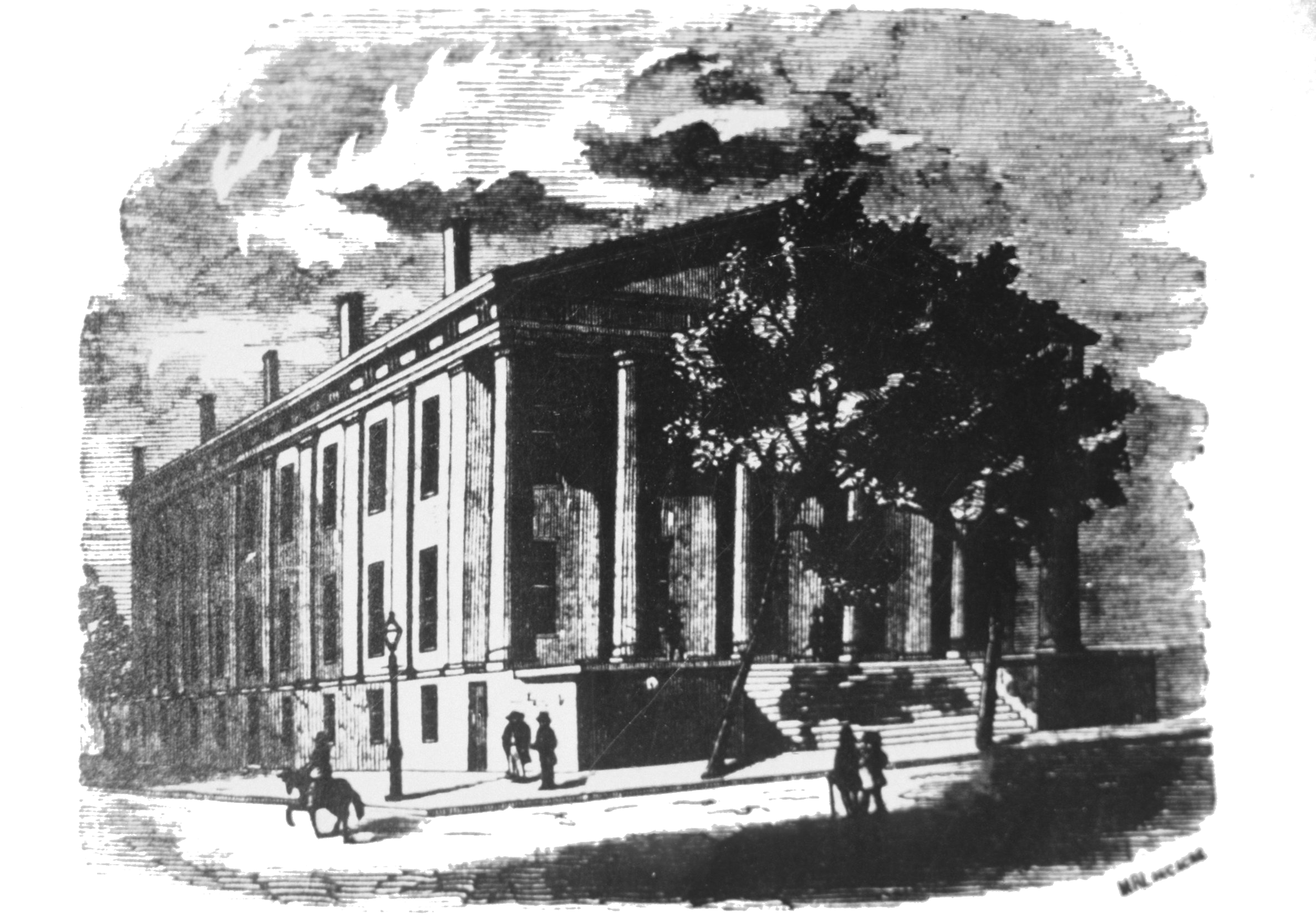
Note: the “Medical Department” and “Medical Institute” nomenclature were common during the 18th and 19th centuries; it would be the equivalent of today’s “School of Medicine.”

In 1799 the newly minted Transylvania University instituted the “Medical Department” at the university. Doctor Samuel Brown was professor of chemistry, anatomy, and surgery and Doctor Frederick Ridgely was professor of materia medica, midwifery, and the practice of physic. The former qualified as professor in October and the latter qualified as professor the following November. Dr. Brown was eventually authorized to import books and other educational materials for the medical professors in the amount of five hundred dollars, an exceptionally large sum of money at the time. In addition to the Medical Department, a school of law was organized as well. In 1805, Doctor James Fishback was appointed as the chair of theory and practice of medicine at the university but resigned in 1806. Doctors James Overton was appointed at the chair of materia medica and botany by 1809. However, by 1815, Transylvania University was reorganized which meant that it was not until 1817-1818 before the Medical Department began full/formal operations. It remains unclear what was taught during the early years of the Medical Department at Transylvania University (though some have noted that instruction was more informal than formal pre-1818).

The Medical Department set out with several goals:
- The School being established in the great Western Valley, will throw much new and important light on the diseases of that Valley, which must lead to a more rational and successful treatment of them
- The School will so far reduce the expenses of medical education in the West, that persons in moderate circumstances, no less than the wealthy, may easily attain it.
- A Western School of Medicine will promote inquiries into the character and effects of the western climate, especially its finluence in producing peculiar diseases, and in modifying common ones, and also into the nature, variety, and uses of the animals, vegetables, and minerals of the West.
- The School will benefit the West, by retaining at home large sums of money, which would be otherwise expended on the education of western youth, in the Schools of the east.
- The School will elevate in the West, the standing and dignity of the medical profession, and give it more weight and influence in effecting its benevolent and praiseworthy purposes.

Dr. Coleman Rogers, a Founder of the School. (From the Courier-Journal, Louisville, Kentucky, 17 January 1957) 
Dr. Lewis Rogers, Son of Dr. Coleman Rogers. (From the Courier-Journal, Louisville, Kentucky, 17 January 1957) 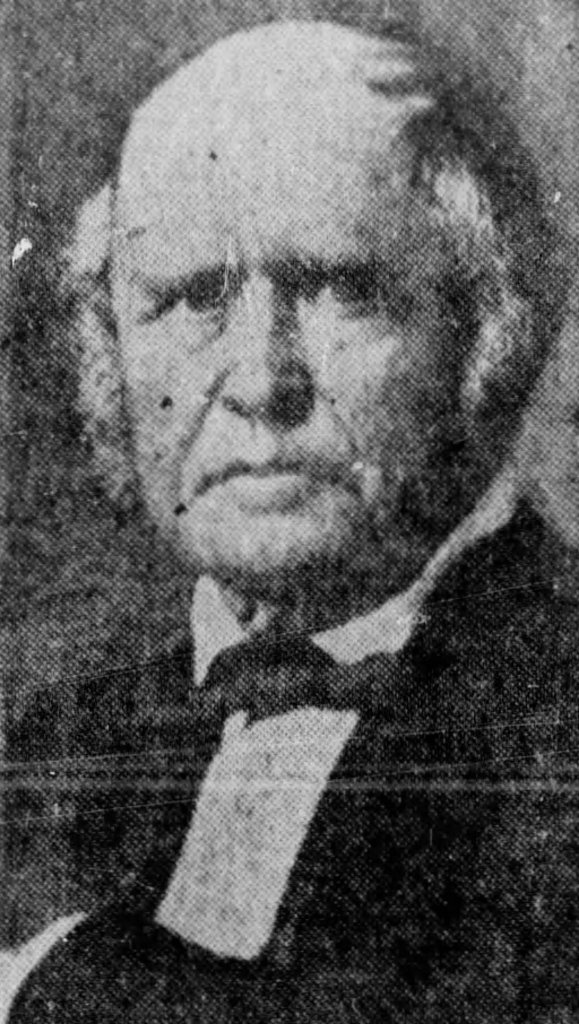
Dr. Charles W. Short, Dean of Medical Department. (From the Courier-Journal, Louisville, Kentucky, 17 January 1957)
In 1817, Daniel Drake took a position as professor at the school of medicine but within a year he resigned his position because of quarreling and disagreements among the faculty members. In 1818 the first Doctor of Medicine degree, west of the Alleghenies, was conferred upon John Lawson McCullough of Lexington. Sessions of the school opened on the first Monday of November every year and would close on the first of March. During this period, each professor would lecture about six times a week with the exception of the professors of anatomy and surgery and the Institutes of Medicine and Medical Jurisprudence which were lectured nine to ten times a week. The school noted that it embraced a provision for the teaching of everything requisite to a liberal education in medicine. The expense per pupil was one hundred and ten dollars for each session. In order to be entitled to become a candidate for a degree, the student must have attended two full courses of lecture at the University unless he attended one full course in some other school of reputable standing. Interestingly, one could practice medicine for a period of four years, take one full course at Transylvania and then become eligible for degree conferral once the prerequisites were met. Examinations for the degrees commenced at the close of each session and would be proctored in front of the faculty. It was noted that “to guard the profession as much as possible against vice, as well as ignorance, measures are also adopted for the moral and religious instruction of the classes.”
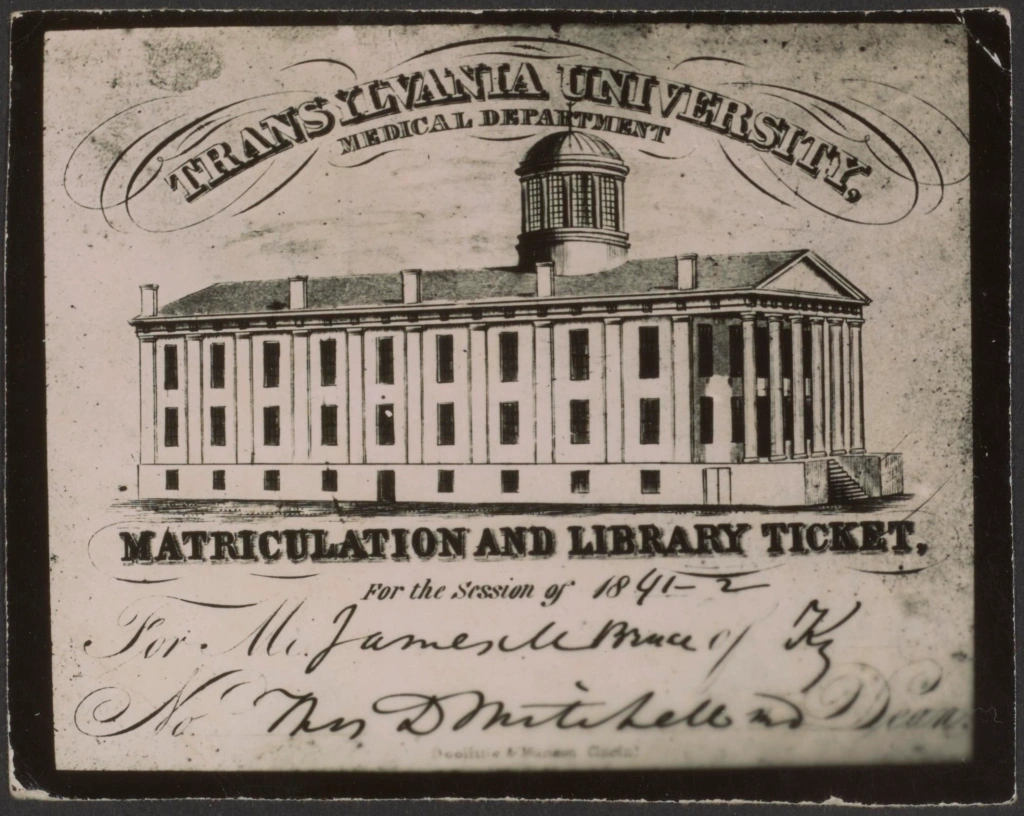
Matriculation and Library Ticket for Transylvania University Medical Department. (From the Clay Lancaster Kentucky Architectural Photographs Collection, University of Kentucky, Lexington, Kentucky)
Between the years 1819 and 1836 there were a total of 3,330 students and 923 of these students graduated. Reports claimed that the Medical Department was the second operating medical school behind the University of Pennsylvania.* During this period, some 1,819 students were from the Commonwealth of Kentucky.
Soon after its inception (and as previously noted), funds were appropriated to build up a collection of books for the establishment of a medical library and medical instrumentation for the school. The University would soon amass a library of over 3,000 medical and science books. Throughout the middle of the 1850s, the Medical Department remained a prestigious institution. However, the opening of the Louisville Medical Institute meant that enrollment at Transvylvania University Medical Department saw an increased drop. In 1833 the Kentucky Legislature approved a charter for the Louisville Medical Institute (in 1846 the Institute reluctantly became part of the University of Louisville Medical Department). Cadavers were not readily available for anatomization at the University. Disagreements within the staff (from its inception until this point in time) had left many medical students frustrated. As such, they jumped ship to the new University of Louisville Medical Department. The Kentucky School of Medicine was formed in the early 1850s and would go on to merge with the University of Louisville Medical Department in the early 20th-century resulting in one, cohesive school of medicine in Louisville. By 1859, the final class of doctors at Transylvania University Medical Department completed their studies and training.
More than one thousand, eight hundred physicians received their training and graduated from the Transylvania University Medical Department. The Medical Department at Transylvania University operated for more than sixty years before its doors closed. Today, the University still operates (without a medical school) and has a unique museum of medicine and a rare medical library that is unrivaled in many places.
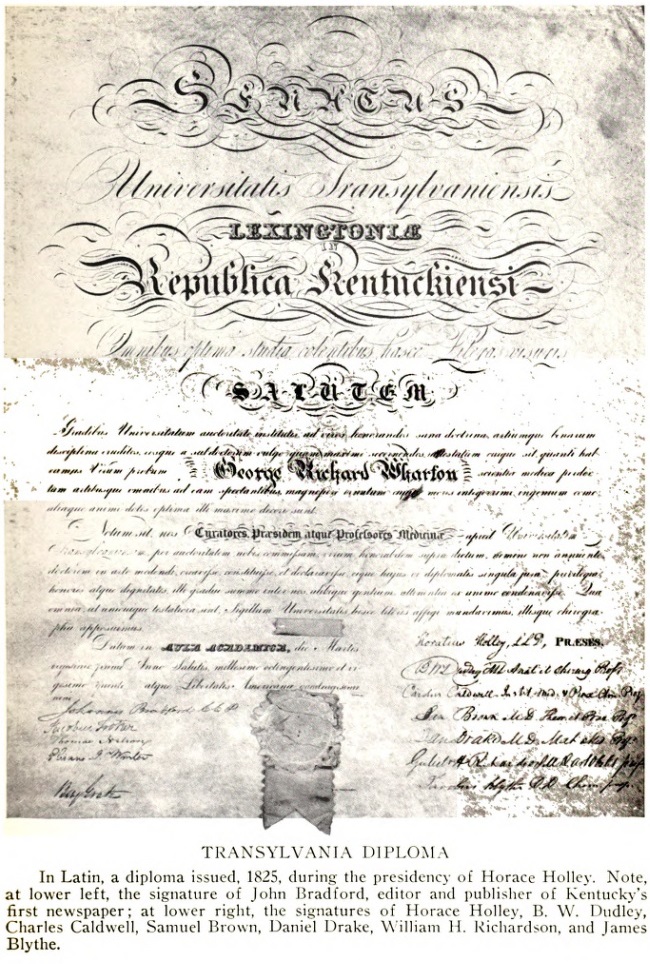
Side Notes
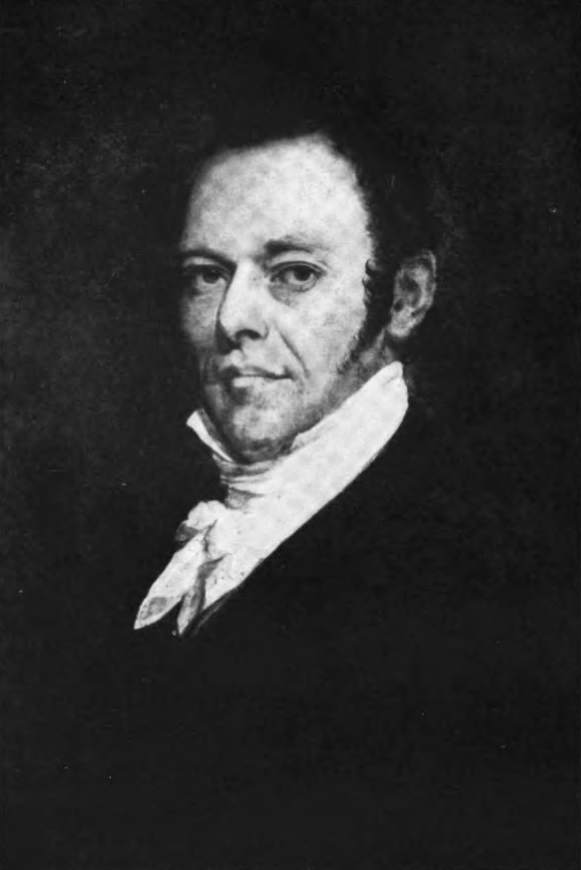
Dr. Benjamin W. Dudley 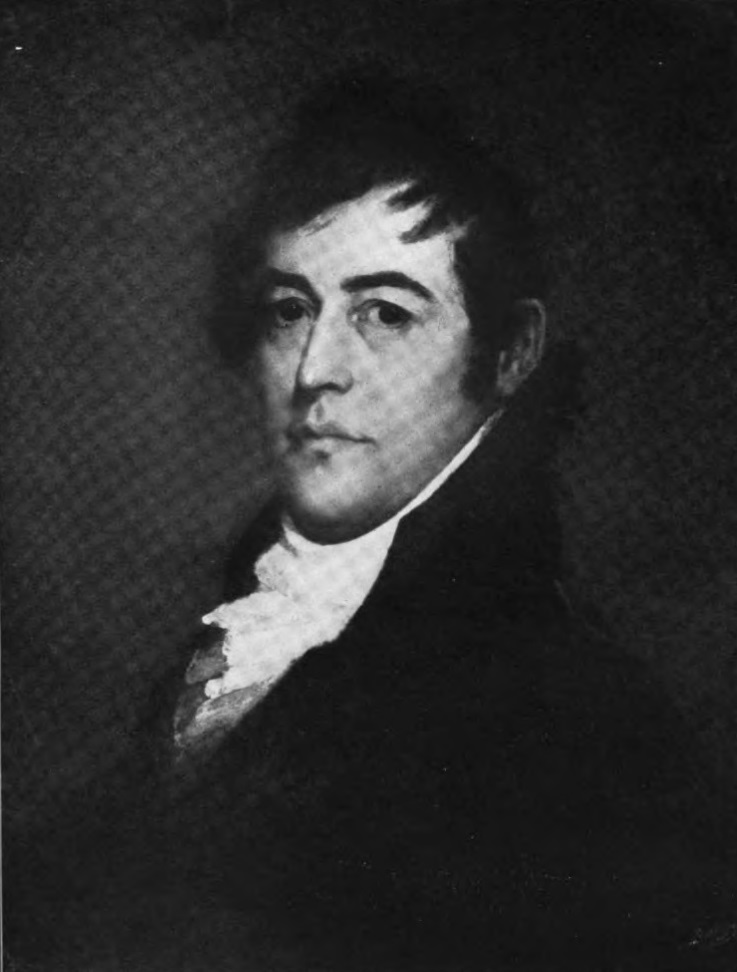
Dr. William H. Richardson 
Dr. Daniel Drake
Dr. B. W. Dudley challenged Dr. Daniel Drake to a duel; the latter refused but Dr. W. H. Richardson agreed to one. Dr. Dudley shot Dr. Richardson in the groin but, in turn, saved his life from the hemorrhage the bullet caused. The two went from being adversaries to lifelong friends. The duel was a catalyst of long-standing issues within the faculty, essentially since its inception. The faculty frequently disagreed and reorganization efforts within the Medical Department, early on at least, did not resolve quickly. The faculty, as customary during this time period, resorted to printing pamphlets in stating their stances or voicing their dissent in regards to management and operations of the Department of Medicine.
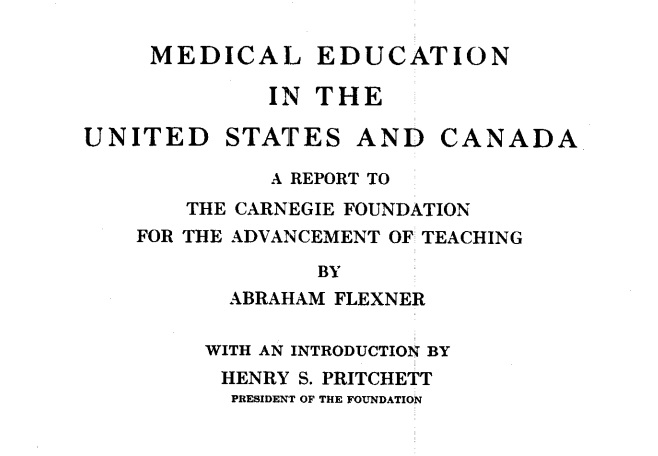
“Abraham Flexner investigated the medical schools of the country for the Carnegie Foundation for the Advancement of Teaching. And he called things as he saw them everywhere. The report was anything but pretty. Apparently, the Louisville schools, and there were eight at the time, saw the handwriting on the wall before Flexner reached the city. They already had begun negotiations for merger by 1907. The collusion among them was so strong, it is said, that when Flexner did make his tour of the schools, equipment of many of them was collected at the school being investigated. When Flexner departed that particular school by one door, the equipment went out another, bound for the next school on Flexner’s itinerary.”
From the Courier-Journal, Louisville, Kentucky
The first merger of schools, in 1908, saw the Louisville Medical College and the Hospital College of Medicine combined into the Louisville Hospital College of Medicine, and the Medical Department of the University of Louisville absorbed into the Medical Department of the University of Kentucky. The Kentucky School of Medicine remained independent. By the time the Flexner report was due for publishing in 1909, the three remaining big schools had merged into the Medical Department of the University of Louisville. Interestingly, the American Medical Association’s Council on Education characterized Louisville as one of the five “especially rotten spots in the country.”
*Transylvania University Medical Department was approximately the fifth medical school to be organized in the United States at that time.

Contributed by Shawn Logan | contact@kyhi.org
⁘ Works Cited ⁘
- Kentucky State Department of Health and the Kentucky State Medical Association. Medicine and its Development in Kentucky. The Standard Printing Company: Louisville, KY. 1940.
- McCormack, Joseph Nathaniel. Some of the medical pioneers of Kentucky. Bowling Green, KY: Times-Journal Pub. Co. 1917.
- Peter, Robert and Johanna Peter. The History of the Medical Department of Transylvania University. Louisville, KY: J. P. Morton & Company, Printers. 1905.
- The Courier-Journal (Louisville, Kentucky) 28 May 1899, p. 24.
- The Courier-Journal (Louisville, Kentucky) 17 January 1957, p. 4.
Important note:
If you would like to use any information on this website (including text, bios, photos and any other information) we encourage you to contact us. We do not own all of the materials on this website/blog. Many of these materials are courtesy of other sources and the original copyright holders retain all applicable rights under the law. Please remember that information contained on this site, authored/owned by KHI, is provided under a Creative Commons Attribution-NonCommercial-NoDerivatives 4.0 International License.
Photographs, text, illustrations and all other media not authored by KHI belong to their respective authors/owners/copyright holders and are used here for educational purposes only under Title 17 U.S. Code § 107.
